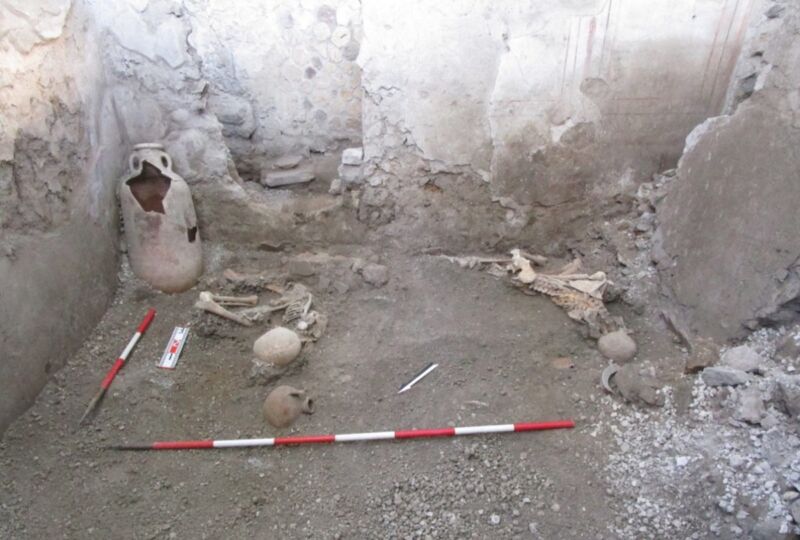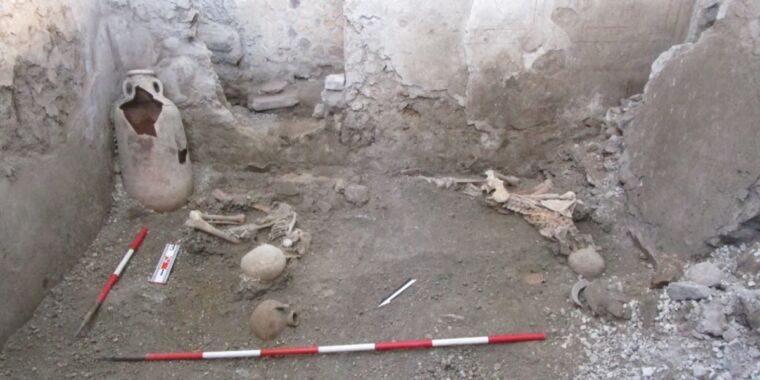
Archaeological Park of Pompeii
Archaeologists have fiercely debated the exact cause of death of those who perished in Pompeii when Vesuvius erupted in 79 AD. Did they die from suffocation, the extreme heat, or a combination of factors? A new paper published in the journal Frontiers in Earth Science examines the complicating effects of earthquakes that occurred just before and at the same time as the eruption. Most intriguing was the discovery of two skeletons of people who likely died when their shelter collapsed around them, weakened by the seismic shaking.
As previously reported, the eruption of Vesuvius released thermal energy approximately equal to 100,000 times the atomic bombs dropped on Hiroshima and Nagasaki at the end of World War II, spewing molten rock, pumice and hot ash over the cities of Pompeii and Herculaneum in particular. Archaeologists believed that the vast majority of victims died of asphyxiation, suffocating in the thick clouds of poisonous gas and ash.
However, a 2001 study in Nature, co-authored by University of Naples archaeologist Pierpaolo Petrone, estimated a temperature of 500° Celsius (932° Fahrenheit) for the pyroclastic surge that devastated Pompeii, enough to kill inhabitants in fractions of a second. In 2018, we reported on Petrone’s conclusion that residents of Herculaneum may have suffered a similar fate. He observed fractures in the bones of about 100 excavated skeletons, as well as “cracking and exploding” of the skullcaps, consistent with forensic cases of skulls cracking due to extreme heat.
Petrone’s follow-up study in 2020 provided additional evidence that extreme heat killed many of the victims, based on analysis of the skull of one victim in particular, first excavated in the 1960s at Herculaneum. There was evidence of brain matter inside the skull. Normally, such brain matter would be “saponified” by the extreme heat—that is, turned into soap (glycerol and fatty acids). But this victim’s brain matter had been vitrified—that is, fused into glass. Later that year, Petrone reported new evidence that this may indeed have been the case, and announced his discovery of preserved human neurons in the victim with the “vitrified” brain, although other scientists were skeptical of the finding.
A 2023 multidisciplinary analysis of seven plaster casts from Pompeii concluded that these victims likely survived the early eruption and died of asphyxiation about 20 hours later, though the authors were careful to emphasize that their findings applied only to these specific cases. “It is likely that the catastrophic eruption killed people in a variety of ways,” the authors of that 2023 study wrote, concluding that “generalizing and supporting a single hypothesis of death becomes too reductive.”
Seismic shocks
Now, here’s another twist: Some of Pompeii’s residents may have died from the cumulative effects of the earthquakes and aftershocks. According to Domenico Sparice, a volcanologist at INGV-Osservatorio Vesuviana, and co-authors, there is historical evidence of seismic activity in the decades leading up to the 79 AD eruption. For example, an earthquake in 62-63 AD caused extensive damage to buildings in Pompeii, leaving repairs ongoing 17 years later.

